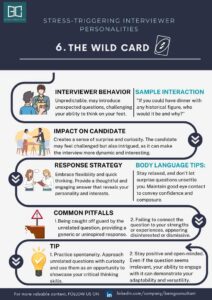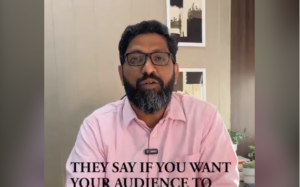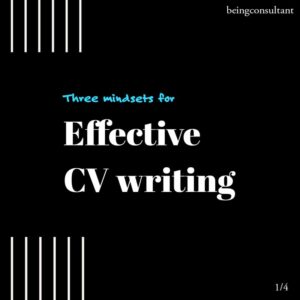Stress Triggering Interviewer Personalities: Navigating Interviews with the Silent Observer
- Uncategorized
- infographic
In the complex landscape of job interviews, candidates often encounter a variety of interviewer personalities. Among these, the Silent Observer stands out as a particularly challenging and often stress-inducing presence. This article delves into the characteristics of this interviewer type, its impact on candidates, and strategies to excel in such interviews, with a focus on the consulting industry where such interview styles are not uncommon.
Introduction: The Power of Silence
Imagine walking into an interview room where your words seem to echo off the walls, met only with silent nods and piercing gazes. Welcome to the world of the Silent Observer interviewer. For many candidates, especially those in high-pressure fields like consulting, this silent scrutiny can be unnerving. However, understanding this interviewer type and preparing accordingly can transform a potentially awkward experience into a powerful demonstration of your communication skills and confidence.
Understanding the Silent Observer
Interviewer Behavior
The Silent Observer is characterized by their minimal verbal input during the interview process. Key behaviors include:
- Listening intently, often more than they speak
- Providing little to no verbal feedback or encouragement
- Utilizing strategic pauses after your answers, creating moments of silence
A typical interaction might involve the interviewer asking a question, listening to your response, and then remaining silent for an extended period. This silence is often a deliberate strategy to prompt further elaboration or to observe how you handle moments of uncertainty.
Impact on Candidates
The Silent Observer’s approach can have significant effects on candidates:
- Increased uncertainty about performance, as there’s little immediate feedback
- Struggle to gauge the interviewer’s reactions or level of interest
- Potential for self-doubt and second-guessing of responses
- Temptation to fill silences with unnecessary information
In the consulting world, where clear communication and composure under pressure are crucial, this interview style can be particularly challenging but also presents a unique opportunity to showcase these very skills.
Strategies for Success: Turning Silence into Your Ally
1. Embrace the Silence
Instead of viewing silence as an uncomfortable void, see it as an opportunity:
- Use pauses to gather your thoughts and structure your responses
- Demonstrate your comfort with silence, a valuable skill in client interactions
- Take the lead in the conversation, showing initiative and confidence
2. Provide Comprehensive Yet Concise Answers
Balancing detail with brevity is key:
- Use the STAR method (Situation, Task, Action, Result) to structure your responses
- Provide enough detail to fully answer the question, but avoid rambling
- After giving your answer, pause briefly to allow the interviewer to interject if needed
3. Lead the Conversation with Clarity and Confidence
Take control of the narrative:
- Use clear transitions between points in your responses
- Summarize key points at the end of longer answers
- Ask thoughtful questions to demonstrate your engagement and interest
4. Leverage Body Language
Non-verbal communication becomes even more crucial in a silent interview:
- Maintain a confident posture: sit up straight, lean slightly forward
- Use hand gestures purposefully to emphasize key points
- Make appropriate eye contact to convey confidence and build rapport
- Use facial expressions to convey engagement and positivity
Avoiding Common Pitfalls
- Misinterpreting Silence: Don’t assume silence means disapproval. It’s often a neutral tool used by the interviewer.
- Overcompensating with Chatter: Resist the urge to fill every silence. Comfort with pauses demonstrates confidence.
- Losing Focus: Stay on topic and avoid drifting into irrelevant information just to fill the silence.
- Forgetting to Observe: While focusing on your responses, don’t forget to pay attention to the interviewer’s non-verbal cues.
Pro Tips for Mastering the Silent Interview
- Practice Strategic Pausing: In your interview preparation, practice incorporating deliberate pauses into your responses.
- Develop a ‘Silence Strategy’: Plan how you’ll use moments of silence – for reflection, emphasizing a point, or transitioning to a new topic.
- Prepare Follow-up Elaborations: For each main point in your preparation, have additional details ready in case you need to expand on your initial answer.
- Use Silence to Your Advantage: After answering a question, you can use silence to prompt the interviewer to engage, saying something like, “I’d be happy to elaborate on any part of that if you’d like.”
- Conduct Mock Interviews: Practice with a partner who plays the role of a Silent Observer to get comfortable with the format.
Conclusion: The Eloquence of Silence
Interviews with Silent Observers, while challenging, offer a unique opportunity to showcase skills that are highly valued in consulting and many other professional fields. These include clear communication, composure under pressure, and the ability to lead a conversation effectively.
By embracing silence, providing thoughtful and structured responses, and maintaining confident body language, you can turn what might seem like an awkward interview into a powerful demonstration of your professional capabilities. Remember, the Silent Observer isn’t trying to trip you up; they’re assessing how you communicate and handle ambiguity – key skills in many high-level positions.
As you prepare for your next interview, consider the possibility of facing a Silent Observer. View it not as an obstacle, but as a chance to shine in ways that a more conventional interview might not allow. With the right preparation and mindset, you can master the art of silence and use it to eloquently convey your strengths and suitability for the role.
In the world of consulting, where client interactions often involve navigating uncertain and sometimes silent moments, mastering this interview style can be a testament to your readiness for the challenges ahead. Embrace the silence, and let your confidence and clarity speak volumes.
Want to land your dream consulting job?
Our 'Break into Consulting™' program offers personalized 1:1 coaching, case mastery, and continuous mentorship until you succeed.








